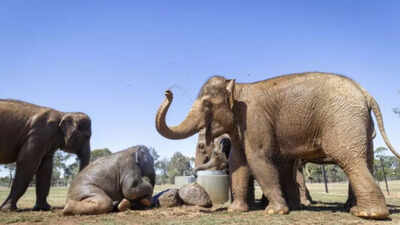ARTICLE AD BOX

Australia's captive elephants are relocating to a more spacious habitat, which marks a significant shift in their care, reflecting a growing recognition of the complex social and spatial needs of these intelligent animals.
Zoos are attempting to provide a better quality of life by allowing the animals to interact and roam in a more natural environment. This development brings the living conditions of the elephants closer to their natural habitat. It also acknowledges the importance of space and social interaction for these highly social creatures.The move is expected to enhance their overall well-being and stimulate their natural behaviors.
By mimicking their wild environment, the zoo aims to promote a healthier, more fulfilling life for the elephants.
Australia’s elephants form new herds, as zoos shift toward open habitats
Elephants are social animals, specifically females. In the wild, they live in multigenerational family groups- grandmothers, mothers, aunts, cousins, and siblings. They can number up to 60 in herds. But now discussions are being made about whether the animals should be kept in captivity at all. According to TheGuardian, Permai, a female elephant, made the 2700 km trip across the Nullarbor plain to join a makeshift herd at Monarto Safari Park, in regional South Australia.
There, she joined Burma from Auckland, and two female elephants from Taronga Zoo, Sydney, who arrived in April. Perth’s male, Putra Mas, will arrive later in the year. In February, Melbourne Zoo’s herd of nine was also transported to a new 21-hectare habitat at Werribee Open Range Zoo. Soon, of Australia’s 27 elephants, only two adult males will remain in the city, at the privately owned Sydney Zoo.
Bonds and ties of the elephants
Elephants are more likely to have neutral or positive interactions, while unrelated animals tend to have more unfriendly interactions.
In those cases, space and the ability to move away is important. The keepers have been allowing the elephants to settle in slowly, introducing them in stages to their new digs, which include an elephant barn, areas of pasture and trees for grazing, and deep pools for swimming. Grazing is a new activity and natural behaviour; it was not available earlier in the city.
Continuing challenges
The animal welfare organisation has concerns about the breeding of elephants in captivity and has advocated for stopping the importation of elephants into America.
Although open plain zoos offer more space for them to roam, social interaction remains limited due to relatively small herd sizes compared to those in the wild. According to reports, the Royal Society for the Prevention of Cruelty to Animals (RSPCA) does not believe that elephants should be kept in zoos, as it is difficult to meet their physical and mental needs in a captive environment. Elephants need space to exercise, a protective social life, and a stimulating environment to engage their considerable physical and cognitive capabilities.
Researchers say that the shift from city enclosures to open-range zoos is a positive step, but not the end goal.
Globally, an estimated 18,000 elephants live in captivity – in zoos, logging camps, sanctuaries, and tourism facilities. As a species with a long lifespan, even if no more elephants were born in captivity, many would continue to live in those settings for decades to come.Also read |47-million-year-old snake found may be the biggest ever, surpassing Titanoboa



.png)
.png)
.png)
















 17 hours ago
3
17 hours ago
3









 English (US) ·
English (US) ·